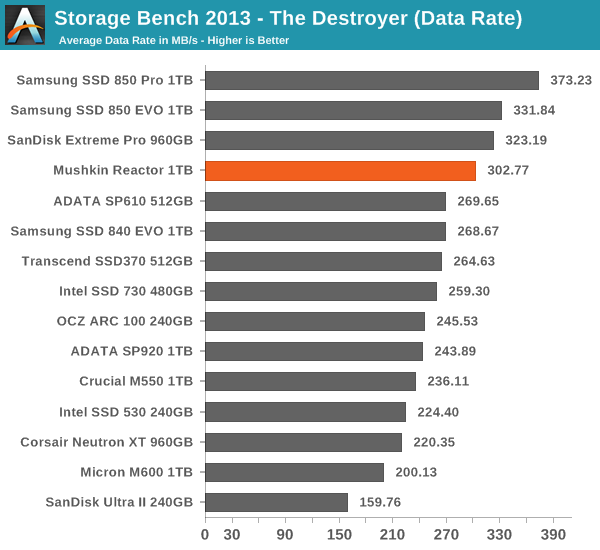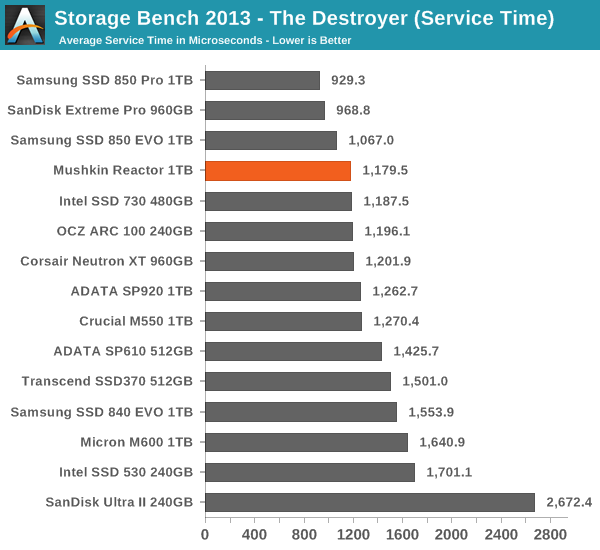Mushkin Reactor 1TB SSD Review
by Kristian Vättö on February 9, 2015 11:32 AM EST- Posted in
- Storage
- SSDs
- Mushkin
- Silicon Motion
- SM2246EN
- Reactor
- Micron 16nm
AnandTech Storage Bench 2013
Our Storage Bench 2013 focuses on worst-case multitasking and IO consistency. Similar to our earlier Storage Benches, the test is still application trace based – we record all IO requests made to a test system and play them back on the drive we are testing and run statistical analysis on the drive's responses. There are 49.8 million IO operations in total with 1583.0GB of reads and 875.6GB of writes. I'm not including the full description of the test for better readability, so make sure to read our Storage Bench 2013 introduction for the full details.
| AnandTech Storage Bench 2013 - The Destroyer | ||
| Workload | Description | Applications Used |
| Photo Sync/Editing | Import images, edit, export | Adobe Photoshop CS6, Adobe Lightroom 4, Dropbox |
| Gaming | Download/install games, play games | Steam, Deus Ex, Skyrim, Starcraft 2, BioShock Infinite |
| Virtualization | Run/manage VM, use general apps inside VM | VirtualBox |
| General Productivity | Browse the web, manage local email, copy files, encrypt/decrypt files, backup system, download content, virus/malware scan | Chrome, IE10, Outlook, Windows 8, AxCrypt, uTorrent, AdAware |
| Video Playback | Copy and watch movies | Windows 8 |
| Application Development | Compile projects, check out code, download code samples | Visual Studio 2012 |
We are reporting two primary metrics with the Destroyer: average data rate in MB/s and average service time in microseconds. The former gives you an idea of the throughput of the drive during the time that it was running the test workload. This can be a very good indication of overall performance. What average data rate doesn't do a good job of is taking into account response time of very bursty (read: high queue depth) IO. By reporting average service time we heavily weigh latency for queued IOs. You'll note that this is a metric we have been reporting in our enterprise benchmarks for a while now. With the client tests maturing, the time was right for a little convergence.

The Reactor does very well in our 2013 Storage Bench and is only beaten by the more expensive SanDisk and Samsung. Among the more value-oriented 1TB SSDs, the Reactor seems to be taking the lead.











69 Comments
View All Comments
Samus - Monday, February 9, 2015 - link
The other performance "limitation" is program/file demands. The vast majority of files, program data, video files and game data are under 5000MB in size...so the difference between a 500MB/sec and a 1000MB/sec drive is a matter of seconds and sometimes milliseconds if reading files <1000MB.The spotlight for my SSD is loading Battlefield 4 levels. I noticed no difference when going from a SATA3 drive to an M2 PCIe drive. The limitation is somewhere else, possibly my 2 year old Xeon CPU? Who knows. But the only place I notice a difference is when unRARing lots of huge files. Since Windows 8.1 64-bit only loads about 800MB of data from the drive during boot (that's what I measured in NAND reads between reboots) again, the difference between a 500MB/sec and 1000MB/sec drive is virtually nothing for everyday computing.
The demand will eventually come for faster SSD's in the consumer space (they're already in the enterprise space, they have been for years) but it probably won't come from Microsoft as their OS's are leaner and leaner every generation. Windows 8 had lower system requirements than Windows 7, and Windows 7 had lower system requirements than Vista. And Windows 10 will run on virtually anything, even Intel's Quark-based SoC dev platform (400MHz P55C "Pentium 3" based)
Uplink10 - Wednesday, February 11, 2015 - link
It is true Windows 8 has lower system requirements but I tested latest Windows 8.1 with updates and Windows 7 SP1 with updates and figured out that Windows 8.1 is more RAM hungry, I switched to Windows 8.1 and I keep getting messages about closing applications because I am too low on RAM. The real potential of SSD over HDD is random writing/reading not sequential. For me 6 Gbit/s sequential bandwidth is enough because I care about random write/read which doesn`t come close to 6 Gbit/s.Christopher1 - Sunday, February 15, 2015 - link
One of your applications must be seriously RAM-hungry then. I have 4 or 5 browsers open and a few other programs at the same time, with page file turned off on a 8GB of RAM system and I never have it squawk about needing more RAM.Now, when I open a serious game like Arkham City, THEN it starts squawking from time to time because AAA-games are seriously RAM-hungry.
Sabresiberian - Monday, February 9, 2015 - link
You make a very good point Solandri, but the limit of the PCIe interface is far higher than the 800 MB/s figure you used; that is pretty much a bottom-end stat. Also, NVMe>AHCI. :)Solandri - Tuesday, February 10, 2015 - link
Mathematically, PCIe can *never* speed things up more than the jump from SATA2 to SATA3. If you look carefully at the chart I made, going from SATA2 to SATA3 sped the 1GB read by 2 sec (from 4 sec to 2 sec).Since the total read time over SATA3 is already 2 sec, the only way to increase read speed by another 2 sec is to go up to infinite MB/s. Even if you used the 8 GB/s limit of PCIe x16, the read time would be 0.125 sec, or a 1.875 sec speedup. Less than the 2 sec you spend things up going from SATA2 to SATA3.
The vast majority of the speed gains that can be gotten from SSDs (with respect to read/writes which benefit from PCIe) have already been gotten. Further improvements will be nice, but never impact computing to the degree that the initial SATA SSDs did. Read my comment to bug77 below for where we should be looking for significant speed gains next.
Christopher1 - Sunday, February 15, 2015 - link
Actually, there is way to speed up things: By making a architecture that can handle bigger 'chunks' of data at a time. As games and other things are getting bigger, you need to load more data at a time in a shorter period. Therefore, increasing the rate at which data from the hard drive can get to RAM is the bottleneck and there can be improvements in that.Either by pre-loading data to RAM (inefficient) or by making it so that data can get from the hard drive/SSD drive to the RAM faster when needed/called.
bug77 - Tuesday, February 10, 2015 - link
And that's not even the main advantage of SSDs. The thing the user notices the most is the nearly non-existent seek time. But you get that even from first generation of SSDs.As a refresher, try to remember what happened when you started multiple, parallel, copy operations on a single HDD: the transfer rate took a serious nose-dive and it was all because of the seek time.
Tom Womack - Tuesday, February 10, 2015 - link
This. And it has wonderful second-order consequences; for example, you can still use your computer while it's doing a backup, so it's reasonable to schedule extremely frequent backups to hard disc.Solandri - Tuesday, February 10, 2015 - link
Yup, exactly this. Non-queued 4k read/writes are still mired around 30-70 MB/s due to limitations in seek time (generally imposed by file system overhead). While this is nearly two orders of magnitude faster than HDDs, it's still short of the SATA3 limit by an order of magnitude. So there's still a lot of improvement (time savings) which can be made on this front.Another way to think of it is that these 4k read/writes impact the time you spend waiting a *lot* more than the sequential read/writes. Again, because MB/s is the inverse of time you wait, the bigger MB/s figures matter less, the smaller MB/s figures matter more. Precisely the opposite of what MB/s seems to imply. e.g. If you need to read 1000 MB of sequential data + 1000 MB of 4k files over SATA3:
2 sec = 1000 MB of sequential data @ 500 MB/s
20 sec = 1000 MB of 4k data @ 50 MB/s
So 90% of the total read time depends on the 4k read speed, only 10% depends on the peak sequential read everyone obsesses over. If you want a "fast" SSD, concentrate on getting a drive whose *smallest* MB/s figures (almost always the 4k speeds) are higher than the competition's.
Christopher1 - Sunday, February 15, 2015 - link
SATA3 does cause a little bit of an issue. It is the limiting factor on most drives now, no matter how much faster you make your driver, it's speed limitations bottleneck your hard drive. That is why M.2 is becoming so popular.